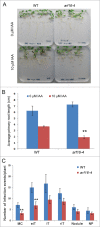Cytokinin responses counterpoint auxin signaling during rhizobial infection
- PMID: 26176899
- PMCID: PMC4623047
- DOI: 10.1080/15592324.2015.1019982
Cytokinin responses counterpoint auxin signaling during rhizobial infection
Abstract
The transcriptomics approach to study gene expression in root hairs from M. truncatula has shed light on the developmental events during rhizobial infection and the underlying hormone responses. This approach revealed the induction of several cyclins and an aurora kinase which suggests that the cell-division machinery plays a role in rhizobial infection. Changes in the cell cycle in plants are governed by hormones, in particular auxin and cytokinin. Through gene expression and genetic analyses, we have shown auxin plays a role during rhizobial infection. Here we provide further analysis of the data showing the induction of a set of cytokinin signaling components. These include genes encoding 2 cytokinin-activating enzymes, the cytokinin receptor CRE1, and 5 type-A cytokinin response regulators. We discuss the possible interactions between auxin and cytokinin signaling during the infection process. We also consider a potential role for cytokinin signaling in rhizobial attachment.
Keywords: Auxin; auxin response factor; auxin responses; cytokinin; cytokinin response regulator; cytokinin signaling; ethylene; hormonal interactions; infection thread; plant microbe interactions; rhizobia; rhizobial infection; symbiosis.
Figures

Similar articles
-
Rhizobium Lipo-chitooligosaccharide Signaling Triggers Accumulation of Cytokinins in Medicago truncatula Roots.Mol Plant. 2015 Aug;8(8):1213-26. doi: 10.1016/j.molp.2015.03.010. Epub 2015 Mar 21. Mol Plant. 2015. PMID: 25804975
-
Flavonoids and Auxin Transport Inhibitors Rescue Symbiotic Nodulation in the Medicago truncatula Cytokinin Perception Mutant cre1.Plant Cell. 2015 Aug;27(8):2210-26. doi: 10.1105/tpc.15.00231. Epub 2015 Aug 7. Plant Cell. 2015. PMID: 26253705 Free PMC article.
-
Rhizobial infection is associated with the development of peripheral vasculature in nodules of Medicago truncatula.Plant Physiol. 2013 May;162(1):107-15. doi: 10.1104/pp.113.215111. Epub 2013 Mar 27. Plant Physiol. 2013. PMID: 23535942 Free PMC article.
-
Into the Root: How Cytokinin Controls Rhizobial Infection.Trends Plant Sci. 2016 Mar;21(3):178-186. doi: 10.1016/j.tplants.2015.09.003. Epub 2015 Oct 14. Trends Plant Sci. 2016. PMID: 26459665 Review.
-
Sending mixed messages: auxin-cytokinin crosstalk in roots.Curr Opin Plant Biol. 2011 Feb;14(1):10-6. doi: 10.1016/j.pbi.2010.08.014. Curr Opin Plant Biol. 2011. PMID: 20926335 Review.
Cited by
-
How Auxin and Cytokinin Phytohormones Modulate Root Microbe Interactions.Front Plant Sci. 2016 Aug 18;7:1240. doi: 10.3389/fpls.2016.01240. eCollection 2016. Front Plant Sci. 2016. PMID: 27588025 Free PMC article. Review.
-
Identification of a core set of rhizobial infection genes using data from single cell-types.Front Plant Sci. 2015 Jul 28;6:575. doi: 10.3389/fpls.2015.00575. eCollection 2015. Front Plant Sci. 2015. PMID: 26284091 Free PMC article.
-
Spatiotemporal cytokinin response imaging and ISOPENTENYLTRANSFERASE 3 function in Medicago nodule development.Plant Physiol. 2022 Jan 20;188(1):560-575. doi: 10.1093/plphys/kiab447. Plant Physiol. 2022. PMID: 34599592 Free PMC article.
-
Identification and Network-Enabled Characterization of Auxin Response Factor Genes in Medicago truncatula.Front Plant Sci. 2016 Dec 9;7:1857. doi: 10.3389/fpls.2016.01857. eCollection 2016. Front Plant Sci. 2016. PMID: 28018393 Free PMC article.
-
MtLAX2, a Functional Homologue of the Arabidopsis Auxin Influx Transporter AUX1, Is Required for Nodule Organogenesis.Plant Physiol. 2017 May;174(1):326-338. doi: 10.1104/pp.16.01473. Epub 2017 Mar 31. Plant Physiol. 2017. PMID: 28363992 Free PMC article.
References
-
- Breakspear A, Liu C, Roy S, Stacey N, Rogers C, Trick M, Morieri G, Mysore KS, Wen J, Oldroyd GE, et al.. The root hair “infectome” of medicago truncatula uncovers changes in cell cycle genes and reveals a requirement for auxin signaling in rhizobial infection. Plant Cell 2014; 26:4680–701; PMID:25527707; http://dx.doi.org/10.1105/tpc.114.133496 - DOI - PMC - PubMed
-
- Schaller GE, Bishopp A, Kieber JJ. The yin-yang of hormones: cytokinin and auxin interactions in plant development. Plant Cell 2015; 27:44–63; http://www.plantcell.org/cgi/doi/10.1105/tpc.114.133595; PMID:25604447 - DOI - PMC - PubMed
-
- Saur IM, Oakes M, Djordjevic MA, Imin N. Crosstalk between the nodulation signaling pathway and the autoregulation of nodulation in Medicago truncatula. New Phytol 2011. 190:865–74; PMID:21507004; http://dx.doi.org/10.1111/j.1469-8137.2011.03738.x - DOI - PubMed
-
- Gonzalez-Rizzo S, Crespi M, Frugier F. The Medicago truncatula CRE1 cytokinin receptor regulates lateral root development and early symbiotic interaction with Sinorhizobium meliloti. Plant Cell 2006; 18:2680–93; PMID:17028204; http://dx.doi.org/10.1105/tpc.106.043778 - DOI - PMC - PubMed
-
- Op den Camp RH, De Mita S, Lillo A, Cao Q, Limpens E, Bisseling T, Geurts R. A phylogenetic strategy based on a legume-specific whole genome duplication yields symbiotic cytokinin type-A response regulators. Plant Physiol 2011. 157:2013–22; PMID:22034625; http://dx.doi.org/10.1104/pp.111.187526 - DOI - PMC - PubMed
MeSH terms
Substances
LinkOut - more resources
Full Text Sources
Other Literature Sources
